Bath stones: types and subtleties of choice
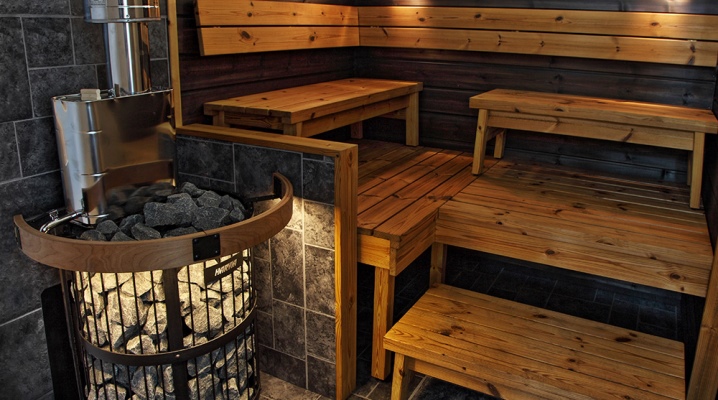
To get the most out of the steam room, it is not enough to choose the right wood for the walls and take into account the heat loss through the roof. The steam room has always been the heart of the Russian bath, and the heart of the steam room has always been a heater. The oven gives off light steam and even heat. The heart of the heater is stones, which must fulfill many functions and have corresponding properties. The stove should heat up quickly and not give off heat immediately, and the stones themselves should not crack when the temperature changes.
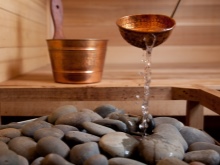

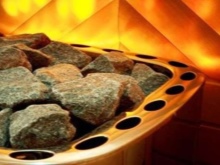
Basic requirements for stones
When choosing stones for a stove, you need to know their features, shape, characteristics, mineral composition. Here's an overview of some of the basic requirements.
- Heat resistance - the breed must tolerate large temperature extremes well. When water gets on a hot stove, the rock has to endure huge loads, because at first they heat up to a maximum, and then their temperature drops abruptly, since the thermal energy goes to evaporate water, and different parts of the same piece of rock lose temperature unevenly.
Not all stones can withstand such conditions and not crack. The higher this characteristic, the more critical conditions the stone will withstand without cracking. There is a simple way to check the density of the rock - just knock on it or expose it to a temperature difference (how to heat up and throw a piece of rock into a container of ice water).
In the event that the stone remains intact after such tests, it is quite suitable for use in the steam room stove. If cracks appear, you should not put it in the stove, there is a risk that the rock will crack and its red-hot pieces will fall on the skin of the steaming ones.
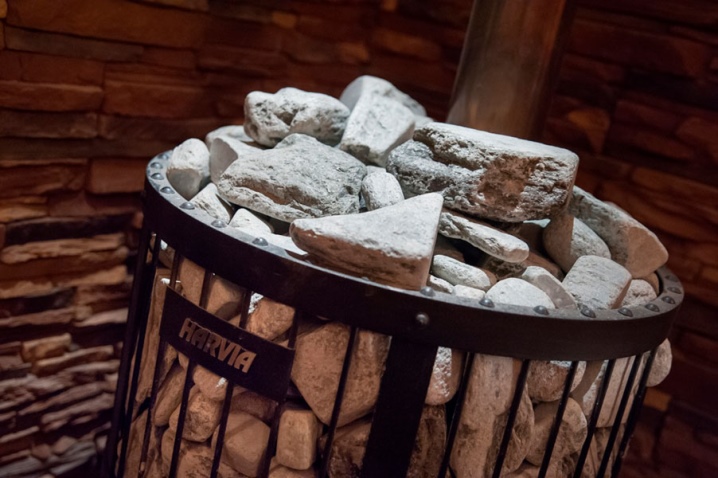
- The level of heat capacity of the stone they call the time during which he is able to remain hot, or the time during which he will give up this heat completely. Heat capacity is the main requirement for a heater. Pieces of rock with high heat capacity should be quite heavy, and their structure should be as homogeneous as possible, without extraneous inclusions, only in this case they will combine both heat capacity and heat resistance.
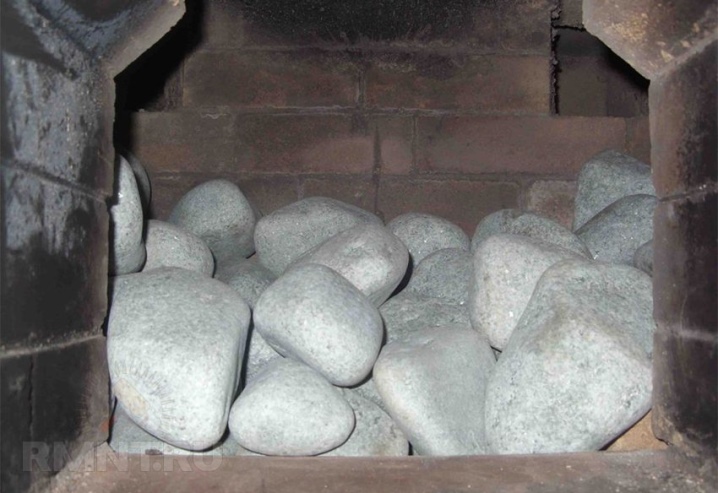
- When selecting the necessary breeds that differ in the above characteristics, you must remember about their dimensions. - a large piece of rock just won't fit into a small steam room. A common mistake is that they try to choose a breed for aesthetic reasons. This is wrong - only the functionality of the breed should be put at the forefront.
A stone 8-16 cm in diameter will perfectly serve in stoves where firewood is used as fuel. For sauna stoves in which electric heating is used, the best option would be a smaller diameter - 5-7 cm.
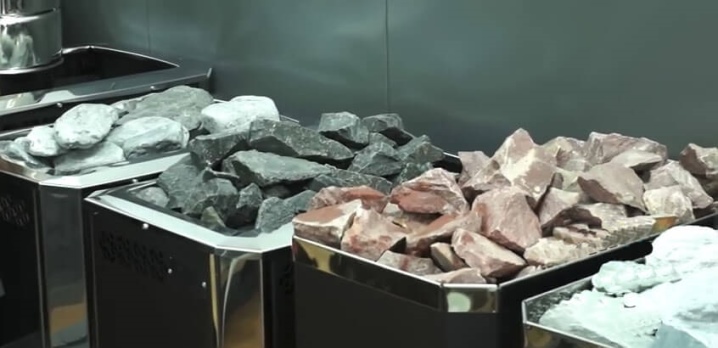
- When choosing a stone, do not forget that the rock is capable of accumulating, absorbing through its pores those substances that get on them from the air, water, soil, albeit in small quantities. Among them, not the safest are those that were produced as a result of technical human activity and which inevitably fall into nature. When a stone is heated, what is contained in it begins to stand out.
Consequently, the ecological safety of stones cannot be disregarded; one must try to pick them up in areas remote from industrial enterprises.
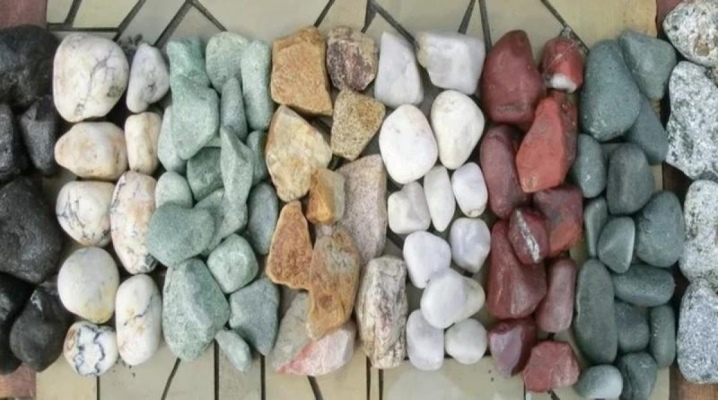
Varieties and properties
Today, a large number of rocks are offered, suitable for use in the bath.
Salt
Strictly speaking, the "salt stone" is not a stone - This is a piece of pure natural structured salt, which was used for the so-called artificial "salt saunas" or "salt caves" not so long ago, where, among other things, walls are lined with it.
It is not forbidden to use it in the stove - evaporating, salt has a tonic effect on the respiratory system, the immune system, helps with skin diseases and allergies.
The salt stone contains potassium, magnesium, iodine, chlorine, calcium, iron, barium, chromium, manganese.
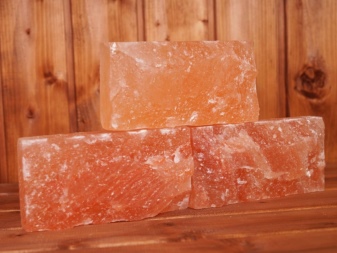
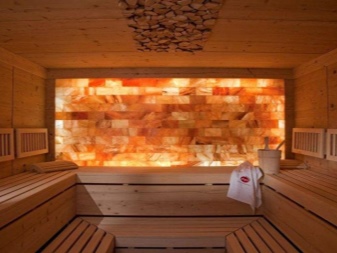
You should not use a salt stone in a bath when:
- high temperature;
- exacerbation of bronchopulmonary diseases (those who are ill or have suffered from tuberculosis in the past, such procedures are prohibited at all);
- intoxications;
- heart and blood pressure problems;
- kidney disease.
It has been proven that a temperature of 60 ° C and a humidity of 20 to 40% give the best therapeutic effect, salt is most useful under these conditions. And if the humidity exceeds 74%, the stone will "flow", so when using it in a bath, the humidity must be monitored.
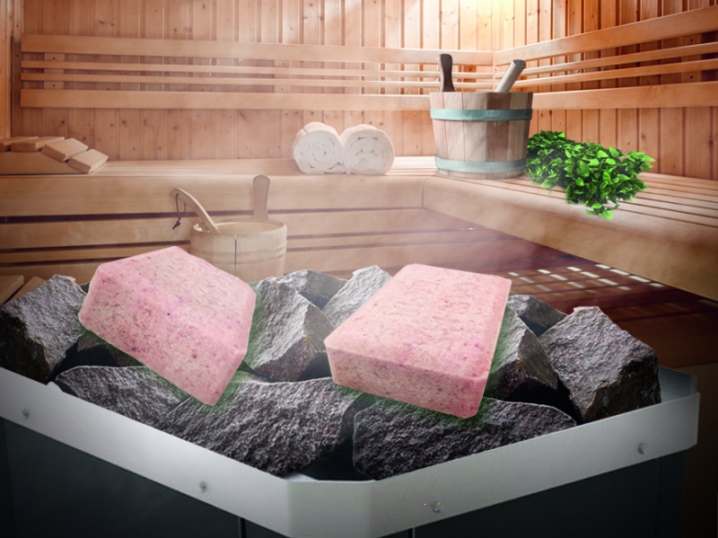
Coil
(other names for the stone are serpentinite, apothecary stone) is characterized by a greenish tint and characteristic "snake" patterns. In the Middle Ages, this stone was revered as one of the most valuable - so it was valued for its unique properties. He was also credited with the ability to protect the owner from someone's unkind influence or "evil eye", decorations from this stone were of considerable importance in Russian culture, including it was appreciated in the construction of baths.
Currently, it is preferred to use as a strong, durable, excellent heat storage material for wall or oven cladding surfaces.
The healing properties of serpentinite were first discovered by healers back in Ancient Russia. It served as material for mortars, containers for storing powders and potions, and in the bathhouse it improved overall health, soothed nerves, helped against colds, kidney diseases, and stabilized blood pressure. Today, doctors have determined that the stone somehow helps to heal bones in fractures.
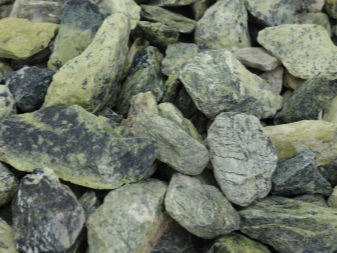

Jasper
Russian rich people used jasper in the bath for a long time. This semi-precious stone does not have a very pronounced structure, but multi-colored green, yellow, red stains on the surface are clearly visible. They tried to heal her internal organs, heart. It was believed that it soothes and strengthens sleep.
It used to be believed that heating the jasper in the stove, the steam would become healing and help women, heal the "obsession", heal the damage. Many of these medicinal properties today have their own scientific basis.
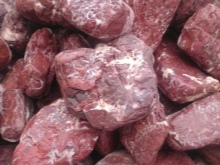
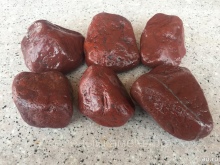
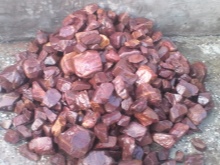
White quartz
It differs in its unusual properties - when heated, oxygen begins to evolve from it. Also, white quartz capable of releasing ozone-containing compounds, which are especially pleasant for the female part of the population, since with the help of ozone the skin is rejuvenated and cleansed.
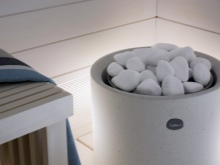
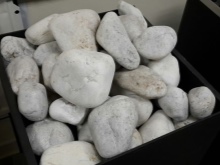

Basalt
Basalt stones are relatively inexpensive, but they are durable, heat-absorbing and can perfectly withstand sudden temperature changes.
In addition, it is noted that due to its antibacterial properties basalt rock cleanses the skin, helps the functioning of the respiratory system, heals migraines and colds.

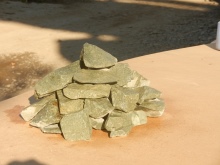
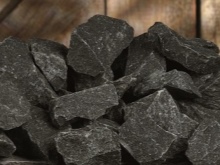
River
If the choice fell on a river or sea pebble, you can accept congratulations, you can save money on it, and besides, pebbles are easiest to find in nature, simply by typing from the ground on the banks of any river or bay. Of course, you can buy pebbles for money, but collecting is clearly cheaper.
The choice is best to stop on the pebbles, having oval or flattened outlines, since they will give less gaps in the masonry, but they will not block the circulation of steam, but, on the contrary, will even improve.
River pebbles are more durable than sea pebbles. If it contains blotches of a red tint, it is undesirable to use the stone, since oxidized iron (FeO, Fe2O3, etc.) gives them a red tint.
The most common use of this type of stones is in the lower tier, so as not to spend a lot of money on stones of other rocks, which are not so easy to collect under your feet.
In general, pebbles in a bath are not very profitable, since they do not have high strength, they have to be inspected and replaced relatively often.
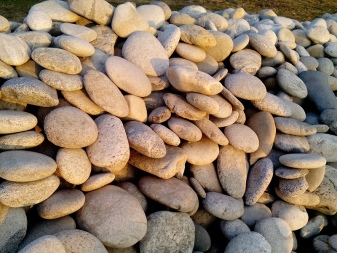
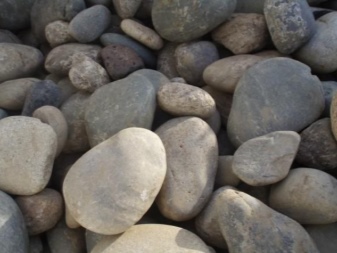
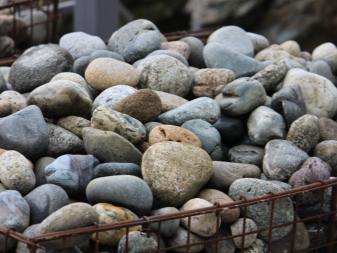
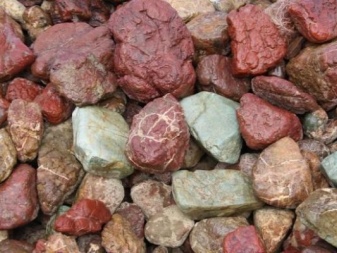
Dolerite
Dolerite is an outdated name for a variety of basalt, but most of all its properties correspond to another common stove stone, also a variety of basalt - gabbro-diabase.
Gabbro-diabase is a rock of volcanic origin. This stone has:
- excellent ability to accumulate heat, as well as its long-term preservation;
- good resistance to sudden changes in temperature;
- high temperature resistance;
- high degree of homogeneity (practically not prone to cracking);
- the classification table states that the degree of its water absorption is 0.19-0.2%
If a gabbro-diabase stone is overheated, it may give off an unpleasant odor, which does not make it too popular among steam room lovers, despite the fact that its prices are quite democratic.
It is also possible for a dark coating to appear on the surface, which occurs after a long and intensive use in the heater. This plaque must be removed or the stones changed, as it is harmful.
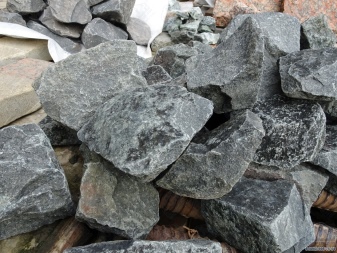

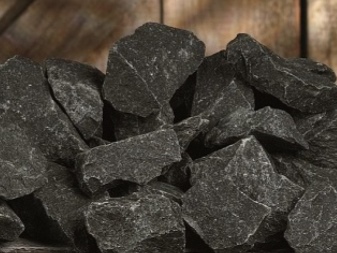
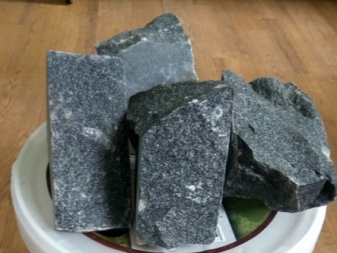
Chromite
Many steam room lovers fill their stove-heater with a noble black filler - chromite. "Heroic stone" (this is the second name of chromite, and sometimes it is called "Black stone" because of its shade) is a high-density magmatic mineral with a large mass, which, as a result of bath procedures, can have a positive effect on a person's ability to have offspring. Also, since ancient times, they were treated for colds.
Chromite is very refractory (it can be melted only when the temperature of the stove exceeds the melting point of aluminum by 2 times), which, given its high density, guarantees its safe use even at very high stove temperatures, and its coefficient of thermal expansion is practically zero.
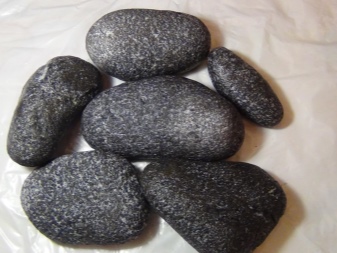
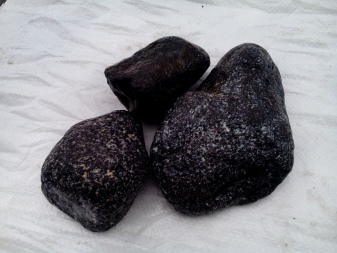


Ceramic
The use of artificial ceramic fillers for the stove is gaining more and more popularity. It can be an alternative to natural stones, because ceramic stones can be given the desired properties, make them safer, increase their heat capacity and heat resistance. Surely they will never be able to completely replace natural stone, but they can perfectly lay the top layer in a heater-stove.
Cast iron fillers can be an alternative to ceramic artificial fillers. They are distinguished by good characteristics - heat capacity, heat transfer, safety (they are not subject to cracking), but they also have significant drawbacks - they do not bring any benefit to the human body and are subject to the destructive action of corrosion, and therefore are relatively short-lived and the rating of professionals in the bathing business is rather low.
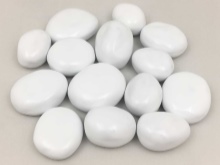
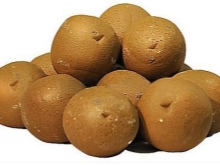
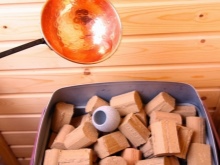
How to choose?
Appearance, when choosing a breed that is planned to be used in a heater-heater, of course, plays a role, you should not forget about it either. Smooth stones with a surface in which foreign inclusions are not visible may well be a suitable option, and besides, they will be safe to use.
It happens that mica veins or traces of another rock are visible in the body of the stone - such stones will not withstand constant temperature changes, since their solidity (homogeneity) is broken, and the formation of cracks is more than likely. To take such material for a heater means to face the need to replace it soon.
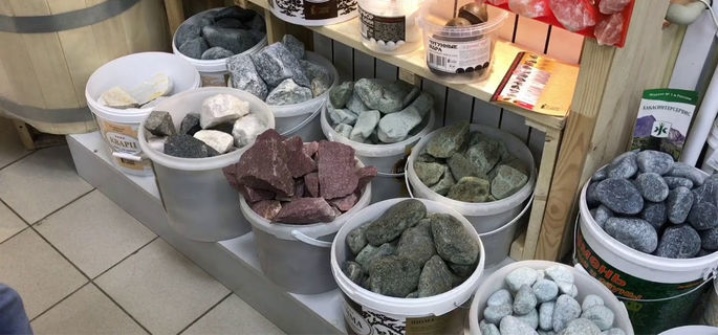
The stove stone can be chipped or polished. Here are their differences.
- Chipped stone are preferred by the regulars of the steam room for the reason that it has large heating faces that are able to form a larger volume of steam when water is splashed on them.
- Polished stone due to the fact that there is more free space between the rounded sides, it creates better circulation, but you have to wait for them to warm up longer than when using a crushed stone.
- When choosing the filling of the stove-heater with rocks, it is important to take into account their origin. Those stones, the rock of which is igneous (volcanic), have a high degree of heat resistance. Sedimentary and metamorphic rocks are not suitable for use in a steam room.
- If the rock contains a lot of silica, it is acidic.... It is also not used in the heater.
- When choosing a stove stone, specialized retail chains you should always check that the package contains a mention of its undergoing special radiation monitoring.
- Using only stones medium and large sizes (supposedly they reduce the evaporation area, therefore, the volume of steam will be insufficient) is not justified, because without using a stone of very small fractions, too much water will have time to flow through and get onto the metal of the top of the furnace. This will result in an unpleasant "metallic" steam taste and premature oven wear due to rust.
- How tightly it is necessary to lay the stone can be determined empirically. - if the steam does not enter the steam room well enough - the styling is broken, something has been done wrong.
The optimal result is masonry thickness from a quarter to a third of a meter. In this case, all the water will probably have time to go into a state of steam, since it will visit both the coldest stones and the hottest ones. As a result, different layers of steam will mix and it will acquire the desired "softness", it will neither be too dry to burn, nor too wet.

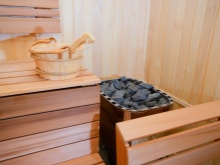
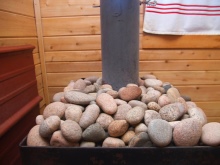
In no case should limestone rocks be used in the steam room., since limestone belongs to soft bottom rocks and, not having sufficient resistance to sudden temperature changes, has high hydrophilicity indicators, and when dried, it is prone to destruction to the state of the dust fraction, which subsequently turns out to be in the lungs of the soaring ones.
It is strongly discouraged to collect stones where the railway lines pass, because all substances and materials that are near the railway contain creosote. This is a harmful chemical that, when heated, with its vapors, can cause severe poisoning if inhaled. The same applies to stones collected in the vicinity of construction sites, waste dumps, etc.
Granite rocks for the steam room are not suitable for the same reason - they have a high content of silica.
If the stones are collected on their own, it is better to move away from water bodies and collect them in the fields. For example, in Soviet times, excellent pebbles were used for filling the bases of power transmission lines (power lines).
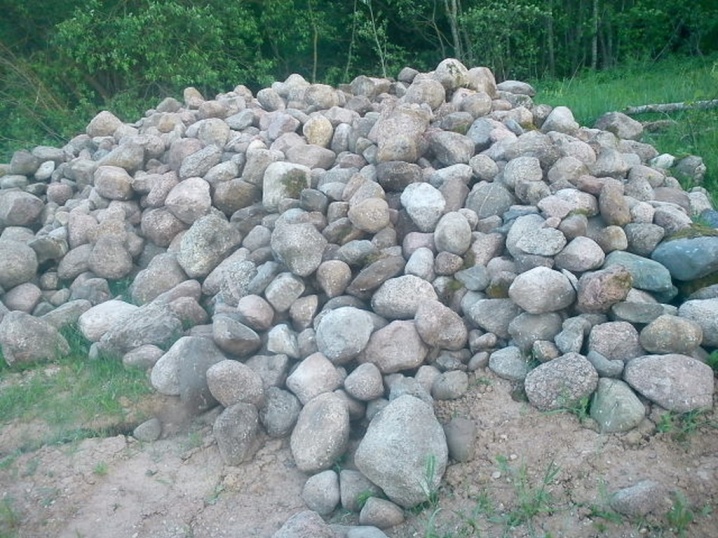
Recommendations for use
Often doubts arise about the order in which the stones should be placed. A high-quality steam room requires a certain arrangement of stones to create favorable conditions for the passage of heated air masses.
You need to act in a certain order.
- It is necessary to start work with thorough washing and drying of all stones.This should be done very efficiently, since any foreign substances will burn when heated, releasing unwanted aromas into the air of the steam room.
- It is necessary to lay them, observing the principle "from large to smaller", that is, the lower tier will consist of large stones. With a gradual increase in height, their size will decrease.
- Those stones that have an oblong shape should be placed "standing", since their surface has a large area and heats up sooner.
- If the stove is heated by electricity, it is necessary to lay the stones loose during the laying process so that the free space separates the heating elements from the stones. This will help the tubular heaters last longer and avoid accidental damage.
During the year, experts recommend "revising" the stones in the stove: check for cracks, chips, harmful plaque and, if necessary, immediately replace them with new ones.
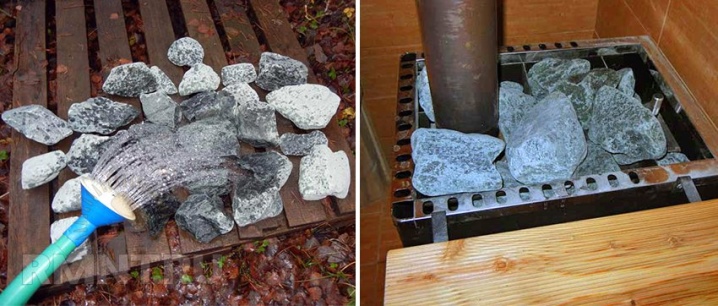
When using essential oils, you need to be prepared for the fact that because of them, the stones will be covered with carbon deposits and you will have to clean and move the stove much more often than usual.
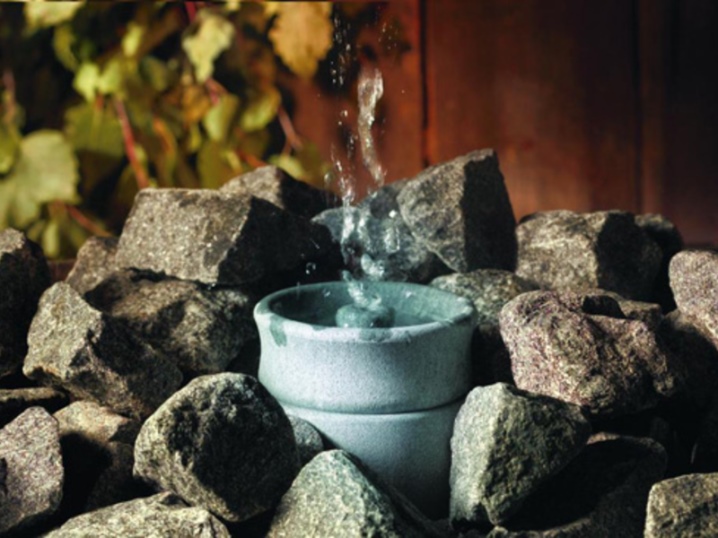
There is a life hack to make the heater warm up faster. To do this, the stones are folded, adding steel or cast iron substitutes to them (they have a shorter heating time, but also faster heat transfer than a natural stove stone).
The quality of the stone can be easily checked by hitting it with a piece of iron / hammer. The appearance of a dull sound means a hidden defect - the stone is heterogeneous and there is a crack inside, and vice versa - a sonorous sound confirms that there are no cracks.
For information on how to choose the best stones for the bath, see below.




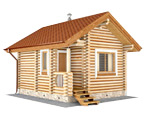
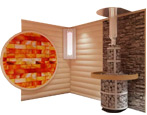
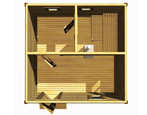
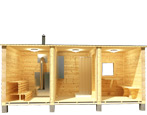
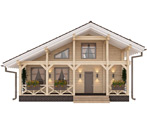
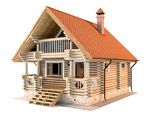


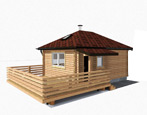
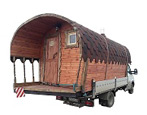


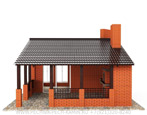

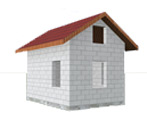

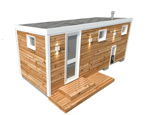
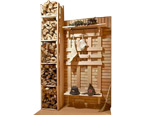

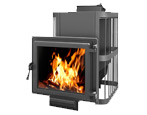
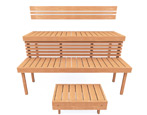


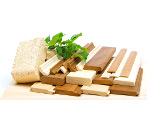


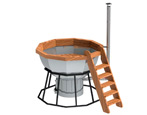
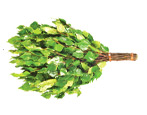
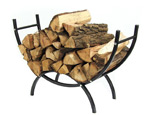
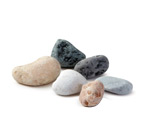
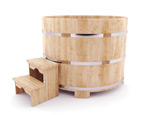
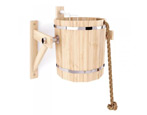
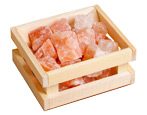


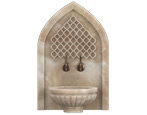

























































The comment was sent successfully.